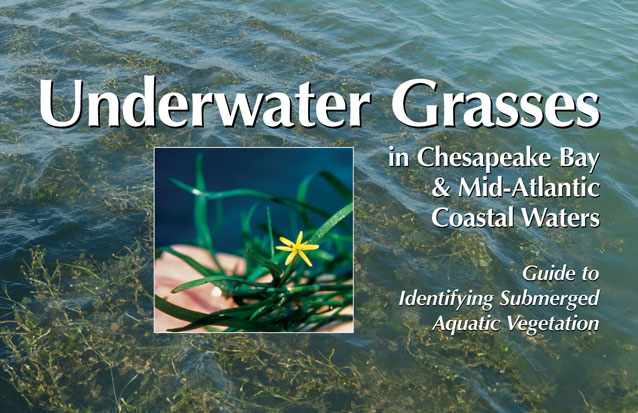Underwater Grasses in Chesapeake Bay & Mid-Atlantic Coastal Waters: Guide to Identifying Submerged Aquatic Vegetation
Author(s):
Bergstrom, Peter W., Robert F. Murphy, Michael D. Naylor, Ryan C. Davis, and Justin T. ReelYear Published:
2006Product ID:
UM-SG-PI-2006-01ISBN:
0-943676-64-9Publisher:
Maryland Sea GrantPrice:
$29.95Page Count:
80 pagesDescription:
Spiral-bound guide, 76 pp. + vi, soft cover, 8.5" wide x 5" tall, 138 color photographs, 55 line drawings, 19 color maps and 2 graphs.
Underwater grasses, or submerged aquatic vegetation (SAV), play a key role in the ecology of coastal waters, and especially in the Chesapeake Bay — the nation's largest estuary. These underwater grasses provide habitat for blue crabs and fish, and food for waterfowl. They help to keep waters clear and offer shelter and living space for many aquatic species.
Over the past several decades, clouded waters — a result of too many nutrients and too much sediment — have blocked sunlight and smothered many SAV beds. Efforts are currently underway to help map, study, and reestablish SAV in the Chesapeake and other coastal waters.
To help citizen volunteers, students, and others interested in learning more about these plants, Maryland Sea Grant has produced a new guide to underwater grasses in collaboration with the National Oceanic and Atmospheric Administration's Chesapeake Bay Office, the Alliance for the Chesapeake Bay, and the Maryland Department of Natural Resources.
Underwater Grasses in Chesapeake Bay & the Mid-Atlantic Coastal Waters features color photographs, line drawings and helpful descriptions of 16 of the most common SAV species, along with other aquatic species you might see. The spiral-bound book is water resistant and printed on heavy stock, similar to the marine mammal guides published by Alaska Sea Grant and Rhode Island Sea Grant. The guide also includes ways to distinguish between similar plants, as well as additional information about floating aquatic vegetation and algae, including algal blooms that can impact water quality. Charts and maps detail the salinity range of each SAV species, including expected salinity ranges in Chesapeake Bay during wet and dry years. Especially useful is an identification key with details about leaves, stems, and other characteristics to help the user identify the plant in hand.






